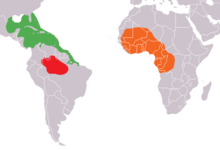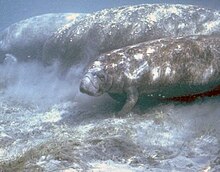Manatees
| Manatees | ||||||||||||
|---|---|---|---|---|---|---|---|---|---|---|---|---|

Caribbean manatee ( Trichechus manatus ) |
||||||||||||
| Systematics | ||||||||||||
|
||||||||||||
| Scientific name of the family | ||||||||||||
| Trichechidae | ||||||||||||
| Gill , 1872 | ||||||||||||
| Scientific name of the genus | ||||||||||||
| Trichechus | ||||||||||||
| Linnaeus , 1758 | ||||||||||||
| species | ||||||||||||
|
The manatees (Trichechidae) derived from the Caribbean-Spanish name Manati also Manatees called, are a family aquatic living mammals . Together with the fork-tailed sea cows or dugongs (Dugongidae) they form the order of the manatees (Sirenia). The family includes three species, all of which fall into one genus, Trichechus : the Caribbean manatee ( T. manatus ), the Amazon manatee ( T. inunguis ), and the African manatee ( T. senegalensis ).
features
The characteristic that gives the German name is the fluke (caudal fin), which is round or spade-shaped. Their physique is round and stocky, their forelegs have been transformed into fins-like flippers that, in contrast to those of the fork-tailed manatees, are provided with nails. The rear limbs are completely regressed and can no longer be found in the skeleton. The small head is characterized by the angular, massive snout, which is provided with numerous whiskers. The upper lip is split, each half can be moved independently of the other. The eyes are small, as are the ear openings, and there is no external auricle. As an anatomical feature, manatees have only six cervical vertebrae and are (almost) the only mammals that do not have seven cervical vertebrae (see sloths ).
Adult animals no longer have incisors or canines , the incisors that are still present in the deciduous teeth are covered by a chewing plate. The number of molars is variable, but there are usually no more than six per half of the jaw. The molars form in the back of the jaw and wear off as they move forward, presumably an adaptation to the plant food mixed with sand. A similar change of teeth is found, for example, in the proboscis , but not in the fork tailed sea cows.
The bones of the body, especially the ribs , are thickened by pachyostosis , which means that the surrounding connective tissue attaches to the bones. This makes the animals heavier and easier to submerge or float in the water.
The gray or brown colored skin is up to 5 centimeters thick. Similar to other marine mammals , manatees appear hairless, although their bodies are covered with short, brush-like hairs.
Manatees are roughly comparable in size to dugongs . They reach a head body length of 2.5 to 4.5 meters and a weight of up to 500 kilograms.
A special feature is the blood supply to the cornea (of the eye), which is caused by the lack of soluble VEGF receptors. The fork tailed sea cow has the soluble receptor and accordingly its cornea is free of blood vessels.
distribution and habitat
Manatees are restricted to the shores of the Atlantic and the river systems that flow into them. In America, their distribution area extends from the southeast of the USA ( Georgia and Florida ) over the coasts of Central America and the Caribbean islands to northern South America , where they can also be found in river systems such as the Orinoco or the Amazon deep inland. In Africa, its range extends from the coasts of Senegal to Angola and also includes some rivers such as the Niger and the tributaries of Lake Chad .
So these animals live in both salt and fresh water . In the sea they are mostly found in shallow coastal areas, including lagoons and mangrove areas . But they can also be found in brackish water and rivers. They prefer to stay in waters with over 20 ° C.
Way of life

Like all manatees, manatees are adapted to an aquatic way of life and, in contrast to seals , which have certain similarities in physique but are not closely related, can no longer come ashore. The locomotion in the water is mainly done by the fluke , the front fins are used for maneuvering, contact with other species and for feeding. They usually travel at 3 to 7 kilometers per hour, but in the event of a threat they can reach speeds of up to 25 km / h. In order to breathe, they just stretch the nostrils at the top of the muzzle out of the water; they are unable to breathe with their mouth. The duration of a dive is variable, it averages around 4 minutes, but the animals can stay under water for up to 16 minutes.
Manatees can be diurnal as well as nocturnal. A six to eight hour feeding phase is followed by a six to ten hour resting phase, during which they are either floating under the water surface or lying on the bottom. There are different reports about social behavior; they either live alone or in small family groups. Sometimes several animals form loose associations, for example when eating. Although these associations are characterized by diverse, non-gender-specific body contacts such as mutual hugging or tender nibbling, no hierarchy and no mutual assistance develop.
food
Like all manatees, manatees are herbivores that feed on various plants that grow in or above the water, such as sea grasses , water lettuce or ground nettles . They unintentionally eat small animals again and again. Animals in captivity are known to consume fish , and this diet may also play a role in nature.
Due to the low nutritional value of the plants and their great weight, they eat large amounts of food every day, usually 5 to 10% of their body weight, in exceptional cases even up to 25%.
Reproduction
At least the Caribbean manatee has a distinctive mating ritual, according to which up to 20 males gather around a female ready to conceive and follow him for a week to a month. The cow tries to avoid the sometimes brutal advances of the males, but mating usually occurs several times.
In most regions there should be no fixed mating season, it can reproduce all year round. After a gestation period of twelve to 13 months, a single young is usually born, twins are rare. As with whales , birth occurs tail first. Newborns weigh around 10 to 15 kilograms and are relatively well developed. They can swim and breathe independently on their first day of life, but sometimes ride on the mother's back. Females have two teats in the armpit region with which they suckle the young.
They start eating solid food after one to three months and are finally weaned at one or two years. The mother's close bond with her offspring continues even afterwards. Females reach sexual maturity at three to four years of age, males at around nine to ten years.
Manatees are relatively long-lived animals and can reach an age of around 60 years.
Man and manatees
Manatees were hunted for their meat, fat, and skin, which was made into leather. Fishermen sometimes accuse them of stealing fish from nets, which at least occasionally actually happens, and therefore persecute them. Increasing pollution of water is a growing threat. Animals often also die after collisions with motor boats or because they get caught in fishing nets and drown. All three species are listed as endangered ( vulnerable ) by the IUCN .
mythology
Time and again the manatees are associated with the sirens or mermaids in Greek mythology . However, this association seems to be more recent - Christopher Columbus , who came across Caribbean manatees in the Gulf of Mexico, described them as mermaids.
A very similar mythology has developed with the African manatee in West Africa. The animals are sacred there and they are regarded as former humans. Killing them is taboo and punished.
Systematics
The family includes three species, all of which fall into one genus, Trichechus : the Caribbean manatee ( T. manatus ), the Amazon manatee ( T. inunguis ), and the African manatee ( T. senegalensis ). In addition, there are still unconfirmed reports of a particularly small “pygmy sea cow” in the waters of the Amazon basin .
The earliest representatives of the Trichechidae are documented from the late Eocene or early Oligocene (around 38 million years ago); the family may have had its origin in South America . From the Miocene the genera Miosiren and Amomotherium are documented, which are summarized in the subfamily Miosireninae. In addition to today's species, the Trichechinae also include the extinct genera Potamosiren and Ribodon , all of which lived in South America. The manatees probably arrived in Africa in the late Pliocene or early Pleistocene .
literature
- Ronald M. Nowak: Walker's Mammals of the World . Johns Hopkins University Press, 1999 ISBN 0-8018-5789-9
Web links
Individual evidence
- ^ Trichechus inunguis Assessment
- ↑ Trichechus manatus Assessnent
- ↑ Trichechus senegalensis Assessment
- ^ JC Cooper: Symbolic and Mythological Animals . Aquarian Press, London 1992, ISBN 1-85538-118-4 , p. 157.


